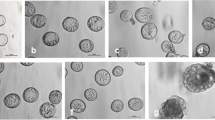Abstract.
Microspores of Brassica napus L. cv. Topas, undergo embryogenesis when cultured at 32.5 °C for the first 18–24 h and then at 25 °C. The first division in heat-treated microspores is a symmetric division in contrast to the asymmetric division found after the first pollen mitosis in-planta or in microspores cultured continuously at 25 °C. This asymmetric division is unique in higher plants as it results in daughter cells separated by a non-consolidated wall. The cytoskeleton has an important role in such morphological changes. We examined microtubule (MT) organization during the first 24 h of heat induction in the embryogenic B. napus cv. Topas and the non-embryogenic B. napus breeding line 0025. Preprophase bands (PPBs) of MTs appeared in cv. Topas microspores in late uninucleate microspores and in prophase figures after 4–8 h of heat treatment. However, more than 60% of the PPBs were not continuous bands. In contrast, PPBs were never observed in pollen mitosis; MT strands radiated from the surface of the nuclear envelope throughout microspore maturation to the end of prophase of pollen mitosis I, during in-planta development and in microspores cultured at 25 °C. Following 24 h of heat treatment, over 95% of the microspores appeared to have divided symmetrically as indicated by the similar size of the daughter nuclei, but only 7–16% of the microspores eventually formed embryos. Discontinuous walls were observed in more than 50% of the divisions and it is probable that the discontinuous PPBs gave rise to such wall abnormalities which may then obstruct embryo development. Preprophase bands were not formed in heat-treated microspores of the non-embryogenic line 0025 and the ensuing divisions showed discontinuous walls. It is concluded that the appearance of PPBs in heat-induced microspores marks sporophytic development and that continuous PPBs are required for cell wall consolidation and embryogenesis. It follows that induced structures with two equally condensed nuclei, do not necessarily denote symmetric divisions.
Similar content being viewed by others
Author information
Authors and Affiliations
Additional information
Received: 22 October 1998 / Accepted: 28 November 1998
Rights and permissions
About this article
Cite this article
Simmonds, D., Keller, W. Significance of preprophase bands of microtubules in the induction of microspore embryogenesis of Brassica napus . Planta 208, 383–391 (1999). https://doi.org/10.1007/s004250050573
Issue Date:
DOI: https://doi.org/10.1007/s004250050573




